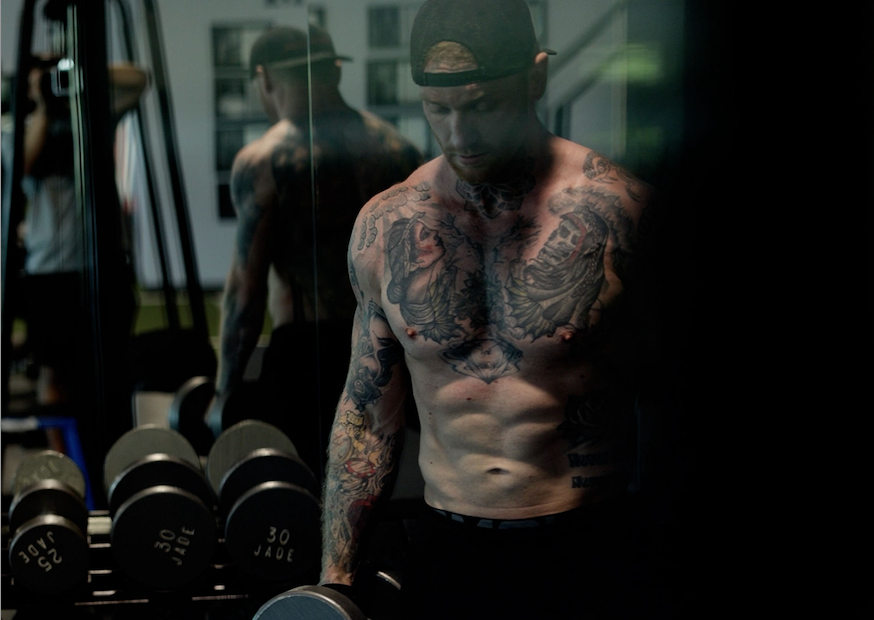Are you ready to build massive biceps and turn heads wherever you go? Look no further! In this ultimate guide, we will reveal the six best exercises you need to try to achieve those bulging biceps you've always dreamed of. Whether you are a beginner or a seasoned weightlifter, these exercises are guaranteed to give you incredible results.
Our brand sets itself apart by prioritizing inclusivity and catering to all fitness levels. We know that building biceps is a goal for many people, so we have crafted this comprehensive guide to help you reach your goals. From targeting different muscle groups to ensuring proper form, we will provide you with all the information and step-by-step instructions you need to succeed.
Throughout this guide, we will also provide valuable tips to enhance your workouts and maximize your gains. So, get ready to sweat, push your limits, and sculpt the biceps of your dreams! Say goodbye to scrawny arms and hello to a new level of strength and confidence.
Join us on this journey as we explore the best exercises for building massive biceps and unlocking your fullest potential. Get ready to transform your arms and transform your life!
Understanding the Anatomy of the Biceps
The biceps brachii, commonly referred to as the biceps, is a two-headed muscle located in the upper arm. It consists of two primary components:
-
Long head – originates from the supraglenoid tubercle of the scapula (shoulder blade)
-
Short head – originates from the coracoid process of the scapula
Both heads merge to form a single tendon that inserts at the radial tuberosity of the forearm, allowing the biceps to function as both a flexor and supinator of the forearm (Standring, Gray’s Anatomy).
Understanding this structure is essential for training both heads of the muscle effectively and achieving balanced development.

Functions of the Biceps
The biceps are involved in two major arm movements:
-
Elbow flexion – bending the arm at the elbow
-
Forearm supination – rotating the forearm to turn the palm upward
This dual action makes the biceps not only a major mover in strength training, but also essential for everyday functional movements like lifting, pulling, and carrying.
The biceps also work in synergy with the:
-
Brachialis – the primary elbow flexor beneath the biceps
-
Brachioradialis – a forearm muscle aiding in flexion, especially during neutral grip movements
This muscular interplay reinforces the need for exercise variety to build a complete, strong arm (Marieb & Hoehn, Human Anatomy & Physiology).
Benefits of Having Strong and Well-Developed Biceps
Upper Body Strength
Strong biceps are foundational to overall upper body power. Whether you’re:
-
Lifting weights
-
Carrying groceries
-
Doing manual labor
...well-trained biceps enhance functional strength and reduce physical strain.
This is especially crucial for athletes and those in physically demanding professions. Biceps strength supports compound movements like rows and pull-ups, boosting performance across multiple activities (Andersen et al., European Journal of Applied Physiology).
Aesthetic Appeal and Body Confidence
Defined biceps are often seen as a symbol of muscularity and are one of the most visually noticeable upper-body muscles. A well-developed pair of arms can:
-
Improve physique symmetry
-
Enhance your appearance in sleeveless clothing
-
Boost self-confidence
In addition to aesthetics, strong arms support sports like rock climbing, swimming, and Olympic weightlifting, where grip and pulling power are vital (Schoenfeld, Journal of Strength and Conditioning Research).
Joint Stability and Injury Prevention
Strong biceps improve elbow joint stability, which is crucial for:
-
Preventing strains and sprains
-
Enhancing load control in heavy lifting
-
Supporting long-term joint health
This becomes even more important with age, as muscle mass naturally declines. Strength training the biceps helps preserve mobility and reduce injury risk in older adults (Peterson et al., Sports Medicine).
By training your biceps consistently—with attention to both muscle heads and the surrounding musculature—you can build functional strength, improve your physique, and support long-term joint health.
The Importance of Proper Form and Technique
Proper form and technique are paramount when training any muscle group, and the biceps are no exception. Using correct form ensures that you're effectively targeting the muscles you're aiming to strengthen while also reducing the risk of injury. Poor technique can result in inadequate muscle engagement and may place unnecessary stress on joints and connective tissues, especially during heavy or complex movements.
According to biomechanics experts, improper lifting technique increases strain on non-targeted joints, particularly the shoulder and lower back, leading to a greater risk of overuse injuries (Escamilla & Andrews, Journal of Orthopaedic & Sports Physical Therapy).
Core Engagement and Controlled Movement
When performing bicep exercises, it's essential to maintain a stable core and avoid using excessive swinging or momentum. Controlled movement helps isolate the biceps, which improves mind-muscle connection and leads to more efficient muscle contractions and growth. This technique also prevents compensation from other muscle groups, such as the shoulders or hips, which can diminish the effectiveness of your training.
Research suggests that strict form—especially in curling motions—leads to greater biceps activation compared to using momentum (Signorile et al., Journal of Strength and Conditioning Research).
The Role of Posture and Positioning
Proper posture throughout your workout protects the spine and shoulder joints, ensuring your training is both effective and safe. Slouched or misaligned posture can transfer strain away from the biceps and onto vulnerable areas like the lower back, reducing efficiency and increasing risk of injury over time.
Maintaining a neutral spine and shoulder retraction during curls allows for optimal arm mechanics, particularly during standing or incline variations (McGill, Ultimate Back Fitness and Performance).
Form Enables Progressive Overload
Mastering technique isn’t just about avoiding injury—it’s also the foundation for progressive overload, a key driver of hypertrophy. When you execute movements properly, you're able to:
-
Safely increase weight
-
Add volume or intensity
-
Push closer to muscular failure
This type of progression is critical for long-term gains in size and strength (Schoenfeld, Journal of Strength and Conditioning Research).
By investing time in learning and perfecting your form, you’re not only protecting your joints—you’re laying the groundwork for consistent, injury-free progress. Ultimately, proper technique is a cornerstone of training success, particularly if your goal is to develop strong, well-defined biceps.
The 6 Best Exercises for Building Massive Biceps
Building massive biceps requires a targeted approach using variety, precision, and progression. The following six exercises have been selected for their proven effectiveness in developing size, strength, and shape in the biceps.
Each movement hits different aspects of the biceps brachii and surrounding muscles, helping prevent plateaus and promote long-term growth. From isolation lifts to compound curls, this lineup supports full-spectrum bicep development. For best results, focus on form, control the tempo, and progressively overload over time.
Whether you're training with free weights, machines, or bodyweight, these exercises can be integrated into any solid upper-body routine. Let’s break down each bicep-building powerhouse and how it can help you grow stronger, more defined arms.
Exercise 1: Elevator Curls
Elevator curls are a high-tension, time-under-tension bicep exercise that emphasizes control, isolation, and total muscle fiber engagement.
How to Perform Elevator Curls:
-
Start with a pair of dumbbells using a supinated grip (palms facing up).
-
Begin to curl the weights, but instead of performing one full rep, pause at multiple checkpoints:
-
¼ way up
-
½ way up
-
¾ way up
-
Full contraction
-
-
At each stop, squeeze the biceps for 1–2 seconds.
-
Lower the dumbbells in the same segmented pattern, pausing on the way down.
This segmented motion keeps the biceps under tension for a longer period, enhancing metabolic stress and fiber recruitment—both of which are key for hypertrophy (Schoenfeld, Journal of Strength and Conditioning Research).
Pro Tips:
-
Use a lighter weight than usual to maintain perfect form throughout each segment.
-
Focus on slow, controlled movement—this is about tension, not speed.
-
Keep elbows tucked at your sides and avoid swinging your upper body.
-
Elevate the effect with INTRA during your session to support hydration and muscular endurance.
Sets & Reps:
-
3–4 sets of 8–10 reps (each rep includes all levels/stops)
-
Rest 60–90 seconds between sets
Incorporating elevator curls into your program once a week can dramatically improve mind-muscle connection, curl strength, and biceps endurance. They’re also a powerful accessory exercise to follow your heavier lifts like barbell curls.
Exercise 2: Dumbbell Curls
Dumbbell curls are a classic and essential bicep-building exercise, known for their simplicity and versatility. Unlike barbell curls, dumbbells allow for unilateral movement, helping correct muscular imbalances between your right and left arms while offering a greater range of motion.
How to Perform Dumbbell Curls:
-
Stand tall with your feet shoulder-width apart.
-
Hold a dumbbell in each hand, arms fully extended by your sides, palms facing forward.
-
Curl both dumbbells toward your shoulders, keeping your elbows close to your torso.
-
Squeeze your biceps at the top of the movement, then lower the dumbbells back down slowly and with control.
-
Repeat for the desired number of reps.
This exercise targets both heads of the biceps brachii and improves overall arm symmetry. It’s also incredibly versatile—you can perform them seated, standing, alternating, or simultaneously. You can also switch to hammer curls or supinating curls to activate different angles of the muscle and supporting muscles like the brachioradialis (Marieb & Hoehn, Human Anatomy & Physiology).
Pro Tips:
-
Avoid swinging or using momentum—keep your core engaged and upper arms still.
-
For greater contraction, rotate your wrist slightly outward (external supination) at the top of the curl.
-
Try alternating arms for greater mind-muscle connection and focus.
-
Pair this with Swolverine Whey Protein Isolate post-workout to maximize muscle repair and growth.
Sets & Reps:
-
3–4 sets of 10–15 reps
-
Choose a weight that allows for controlled form across all reps
Adding dumbbell curls to your weekly arm routine can significantly boost biceps peak, arm definition, and joint stability, especially when combined with other movements like incline curls.
Ready for the next bicep-building move? Just drop it in, and I’ll format and optimize it the same way!
Exercise 3: Twisting Dumbbell Curls
Twisting dumbbell curls (also called supinating curls) are a smart and effective variation of the traditional dumbbell curl that enhances bicep activation and builds a more defined, thicker arm. By incorporating wrist rotation into the curl, this exercise better targets both the biceps brachii and the brachialis—the deep muscle underneath the biceps responsible for width.
How to Perform Twisting Dumbbell Curls:
-
Hold a pair of dumbbells at your sides with a neutral grip (palms facing in).
-
Begin curling the dumbbells upward. As you raise the weights, rotate your wrists outward so your palms face up (supinated) at the top.
-
Squeeze your biceps at peak contraction.
-
Lower the dumbbells in reverse—slowly rotating your wrists back to a neutral grip as you descend.
-
Repeat for the full set.
This exercise enhances the mind-muscle connection by forcing the biceps to work through a longer range of motion and involving the forearms more actively. It also supports a more natural joint alignment, reducing stress on the elbows and wrists (McGill, Ultimate Back Fitness and Performance).
Pro Tips:
-
Focus on a slow tempo, especially during the lowering phase (eccentric).
-
Avoid letting your elbows drift forward—keep them pinned to your sides to isolate the biceps.
-
Don’t overload the weight. This movement is about precision and control, not momentum.
-
Stack recovery by using Collagen Protein to support joint health, especially with high-rep bicep work.
Sets & Reps:
-
3–4 sets of 10–12 reps
-
Rest 60 seconds between sets
Incorporating twisting curls into your routine is a great way to build bicep peak, forearm strength, and muscle density. Use them as a secondary exercise after compound curls like the EZ Bar Curl or Barbell Curl.
Exercise 4: Zottman Curls
Zottman curls are a powerful hybrid movement that combines the best of both traditional curls and reverse curls, creating a comprehensive arm builder that targets the biceps, brachialis, and forearms in a single fluid motion.
This unique variation maximizes time under tension and enhances strength development across multiple muscle groups—making it a must-have in any well-rounded bicep routine.
How to Perform Zottman Curls:
-
Hold a pair of dumbbells at your sides with a supinated grip (palms facing forward).
-
Curl the dumbbells toward your shoulders, keeping your elbows tucked in.
-
At the top of the curl, rotate your wrists outward to switch to a pronated (palms-down) grip.
-
Slowly lower the dumbbells with this overhand grip back to the start position.
-
Rotate your wrists back to supinated grip and repeat.
This two-phase movement stimulates the biceps brachii during the lifting portion and emphasizes the brachialis and forearm extensors during the eccentric lowering phase. Research suggests eccentric loading plays a key role in muscle hypertrophy and tendon strengthening (Douglas et al., Sports Medicine).
Pro Tips:
-
Don’t rush the eccentric (lowering) phase—slow, controlled descent is key.
-
Start with a lighter weight than traditional curls, as the reverse portion demands more forearm engagement.
-
Keep your shoulders down and back to prevent momentum and maintain form.
-
Pair this with Krill Oil for anti-inflammatory benefits that support joint health in the elbows and wrists.
Sets & Reps:
-
3–4 sets of 8–12 reps
-
Rest 60–90 seconds between sets
Zottman curls are a top-tier finisher or mid-workout movement for any arm day. They’re especially effective when paired with standard bicep builders like the Dumbbell Curl or Barbell Curl, delivering well-rounded results in both size and definition.
Exercise 5: Spider Curls
Spider curls are a highly effective isolation exercise that eliminates momentum and keeps constant tension on the biceps throughout the entire range of motion. This positioning enhances both muscle contraction and control, making spider curls a go-to movement for serious arm growth.
How to Perform Spider Curls:
-
Position yourself on an incline bench, chest supported, with the bench set at a slight angle (30–45°).
-
Let your arms hang straight down while holding dumbbells or a barbell with a supinated grip (palms facing up).
-
Keep your upper arms stationary and curl the weight toward your shoulders.
-
Squeeze at the top, then lower slowly and with control to the starting position.
Spider curls eliminate the use of momentum and minimize assistance from other muscle groups, making the biceps do 100% of the work. According to EMG studies, exercises that stabilize the shoulder and reduce torso involvement tend to produce greater muscle fiber activation in isolation lifts (Schoenfeld, Journal of Strength and Conditioning Research).
Pro Tips:
-
Focus on the squeeze at the top—this enhances peak contraction and mind-muscle connection.
-
Keep reps slow and strict, especially during the eccentric (lowering) portion.
-
Avoid leaning forward or shifting your torso—let the biceps do all the work.
-
Recover properly with Whey Protein Isolate post-workout to support lean mass gains.
Sets & Reps:
-
3–4 sets of 10–12 reps
-
Rest 60–75 seconds between sets
Spider curls are ideal as a finisher or accessory exercise, especially after compound movements like Barbell Curls or Dumbbell Curls. Incorporating them into your routine consistently can help you develop fuller, more defined biceps while improving control and isolation.
Let me know if you’d like this exercise dropped into the master article document—or if you’re ready to finalize the post for publishing!
Exercise 6: Incline Dumbbell Curls
Incline dumbbell curls are a powerful bicep-building movement that maximize muscle stretch and activation by increasing the range of motion compared to traditional curls. This extended motion places more tension on the long head of the biceps, which is essential for developing a more pronounced peak.
How to Perform Incline Dumbbell Curls:
-
Sit back on an incline bench set at a 45–60° angle.
-
Hold a pair of dumbbells with a supinated grip (palms facing forward).
-
Let your arms hang fully extended at your sides to stretch the biceps.
-
Curl the dumbbells toward your shoulders, keeping your elbows locked in place.
-
Slowly lower the weights back to the start, maintaining control throughout.
This exercise places the biceps under a deep loaded stretch, which research shows may enhance hypertrophy by stimulating mechanical tension and muscle fiber recruitment (Schoenfeld et al., Strength and Conditioning Journal).
Pro Tips:
-
Keep your elbows back and don’t let them drift forward—it shifts tension away from the biceps.
-
Pause briefly at the bottom to reinforce full stretch and eliminate momentum.
-
Use a moderate weight to maintain strict control throughout the set.
-
Stack with Beta-Alanine for increased endurance, especially in high-rep bicep work.
Sets & Reps:
-
3–4 sets of 8–12 reps
-
Rest 60–90 seconds between sets
Incline curls are excellent as a primary movement or to follow heavier lifts like EZ Bar Curls when training for shape, stretch, and symmetry. By isolating the long head, they help create the peak and fullness that define impressive biceps.
Sample Bicep Workout Routine
To kickstart your journey toward massive biceps, here’s a sample workout routine that incorporates the exercises discussed above. This routine focuses on hypertrophy, promoting muscle growth through moderate to heavy weights and higher repetitions.
Remember to warm up before starting your workout and cool down afterward to aid recovery and reduce the risk of injury (NASM, Warm-Up and Cool-Down Guidelines).
Sample Bicep Workout:
-
Incline Dumbbell Curls – 4 sets of 10–12 reps
-
Dumbbell Curls – 3 sets of 10–12 reps
-
Spider Curls – 3 sets of 10–12 reps
-
Elevator Curls – 3 sets of 8–10 reps
-
Twisting Curls – 3 sets of 10–12 reps per arm
-
Zottman Curls – 3 sets of 10–12 reps per arm
This routine can be performed once or twice per week, depending on your recovery capacity. Make sure to leave at least 48 hours between sessions for adequate rest and muscle regeneration.
As you progress, feel free to adjust weights, reps, and sets based on your individual goals and training level. Consistency is key—so track your progress over time and keep showing up.
Tips for Maximizing Bicep Growth
1. Prioritize Progressive Overload
To stimulate muscle growth, gradually increase the weight, reps, or training volume over time. This principle—known as progressive overload—is the foundation of hypertrophy.
Keep a workout log or app to track progress and ensure you're regularly pushing your limits (Schoenfeld, Journal of Strength and Conditioning Research).
2. Change Your Grip and Angles
Vary your grip width, arm position, and curl style to hit all heads of the biceps:
-
Wide-grip curls → more emphasis on the short head
-
Narrow-grip curls → targets the long head
-
Neutral grips → activate brachialis and forearms
Rotating through variations like hammer curls, incline curls, and preacher curls ensures more balanced growth.
3. Don’t Skip Recovery
Muscle growth happens outside the gym—during rest and recovery. Avoid training biceps on back-to-back days and aim for:
-
48–72 hours of rest between direct bicep sessions
-
Active recovery on rest days (light cardio or stretching)
-
Adequate hydration and sleep
Also, fuel your growth with proper nutrition. Get enough protein to support muscle repair—Whey Protein Isolate is a fast-digesting, high-quality option perfect for post-workout recovery.
Avoiding Common Mistakes in Bicep Training
While pursuing massive biceps, it’s essential to steer clear of common mistakes that can hinder your progress and increase your risk of injury. Smart training isn’t just about intensity—it’s about consistency, variety, and recovery.
1. Lifting Too Heavy, Too Soon
One of the most frequent errors is using too much weight. This often results in:
-
Poor form
-
Excessive swinging or momentum
-
Increased strain on joints and tendons
Instead, prioritize form over load. Begin with a weight that allows for strict, controlled reps, and increase resistance gradually as your strength builds. A clean curl under tension is far more effective than a sloppy lift with heavy weight (Schoenfeld, Journal of Strength and Conditioning Research).
💡 Tip: Use lifting straps only when needed to avoid overreliance—they’re great for support but shouldn’t compensate for poor grip or form.
2. Lack of Variation
Another mistake is doing the same few exercises over and over. This leads to training plateaus, where your muscles adapt and stop growing.
Keep your biceps guessing by:
-
Rotating in new movements like Spider Curls or Zottman Curls
-
Altering your grip width or arm angle
-
Changing rep ranges or tempo
This kind of variety stimulates new muscle fiber recruitment, promotes hypertrophy, and makes your training more engaging.
3. Ignoring Rest and Recovery
Overtraining is real—and it can stall progress fast. Many lifters think more volume = more growth, but muscle repair happens during rest, not while you train.
-
Train biceps no more than 1–2 times per week
-
Take at least 48 hours between sessions
-
Prioritize sleep, hydration, and recovery nutrition
Support recovery with tools like ZMT to boost overnight muscle repair and natural testosterone levels, and Creatine Monohydrate to restore muscular energy between sessions.
🛌 Pro Tip: If you’re excessively sore, fatigued, or feel weaker than usual, take an extra day off or opt for active recovery like walking or yoga.
Conclusion
Building massive biceps is an achievable goal with the right approach and dedication. By understanding the anatomy of the biceps, recognizing the benefits of strength training, and focusing on proper form, you can maximize your results. Incorporating the six best exercises into your routine will help you effectively target the biceps while promoting overall upper body strength.
Remember, consistency and progressive overload are key components of muscle growth. Stay committed to your training, challenge yourself, and ensure that you are allowing for adequate recovery time. Additionally, avoid common mistakes that can impede your progress, and prioritize variety in your workouts to keep your muscles engaged.
With this ultimate guide, you now have the tools and knowledge necessary to embark on your journey toward massive biceps. Embrace the process, push your limits, and most importantly, enjoy the transformation that comes with hard work and dedication. Get ready to turn heads with your impressive arms and newfound confidence!







